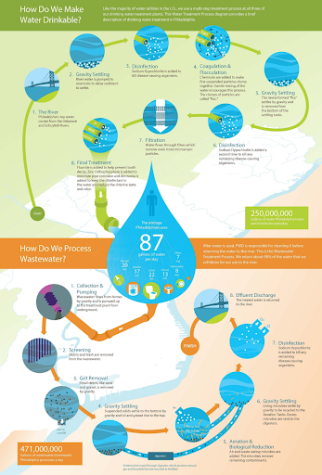Mission to Clean PA’s Drinking Water

Original graphic by Finn Ryan
May 5, 2023
On the evening of Friday, March 24th, a pipe rupture in a Bucks County water plant released more than 8,100 gallons of a latex chemical solution into the Delaware River. As panic swept Philadelphia after the city’s advisory about the contaminated water, many rushed to their local grocery store to stock up on bottled water. The threat, although now dismissed by city officials, represents the latest in a series of concerns and changes to Pennsylvania’s drinkable water system.
The Bristol Altuglas LLC chemical plant, owned by the company Trinseo, produces latex emulsion solution, a water-soluble consumer chemical. Three specific chemicals – ethyl acrylate, methyl methacrylate, and butyl acrylate – entered the river tributary when the pipe broke. Of the side effects, irritation to eyes and skin were most worrisome for residents.

Following the on-site rupture, the released chemicals entered Otter Creek through storm drains, and then the tributary. This region of contamination aligned with the sourcing zones of the Baxter Drinking Water Treatment Plant. Homes and other buildings that receive their tap water from this plant were particularly troubled by the “equipment failure.” The city operates two other treatment plants, Queen Lane and Belmont, on either side of the Schuylkill River. Most plants process wastewater through three different treatments: the Preliminary, Primary, and Secondary Treatments. First, debris and large waste materials are removed and taken to other locations. In the Primary Treatment, smaller solid waste is physically removed. Organic waste is removed in the Secondary Treatment through the combination with sewage-decomposing microorganisms.
Early in the morning on Sunday, the treatment plant reopened its water intake to maintain its minimum levels. The initial reports indicated that Philadelphia tap water was clean. Officials, however, continued to advise the use of exclusively bottled water in cooking. Later in the evening, this alert was rescinded as the Coast Guard collected the contaminated water and assured the city of the system’s safety.
The spill occurred almost two months after Pennsylvania legislatures enacted drinking water limits on “forever chemicals,” products that fail to naturally break down. After the January ruling, 3,117 water systems capped levels of these chemicals in drinking water at “14 parts per trillion for perfluorooctanoic acid and 18 parts per trillion for perfluorooctane sulfonic acid.” Pennsylvania has joined a long list of states, including California, New York, and New Jersey, that have restricted these chemicals. A national limit has not yet been set, although officials have advised limited consumption.
“Forever chemicals” are associated with developmental delays, reproductive concerns, cancer, obesity, and thyroid disease. State agencies began testing these products in 2019 at the treatment plants referenced above. For instance, the Baxter plant – the origin of the March chemical spill – contributed to the development of limit recommendations.
This month, the Environmental Protection Agency (EPA), the body that guides these restrictions, announced its allotment of $266 million to replace lead water pipes in Pennsylvania. The report serves as part of Senators Casey and Fetterman’s “Infrastructure Investment & Jobs Act,” a plan to update and improve the safety and transparency of Pennsylvania’s water system.
The recent news in Pennsylvania’s water safety measures reflect the national trends in environmental reporting. Individuals have grown increasingly conscious of the relationship between humans and nature: our utilization of natural water, for instance, is impacted by the industrial uses of potentially dangerous substances. As Action Earth Co-President Hanna Lyons noted, “it is important for students to make an effort to understand how we impact the environment – and how it impacts us. We are the next generation of leaders and have the power to make this relationship as sustainable as possible.”






